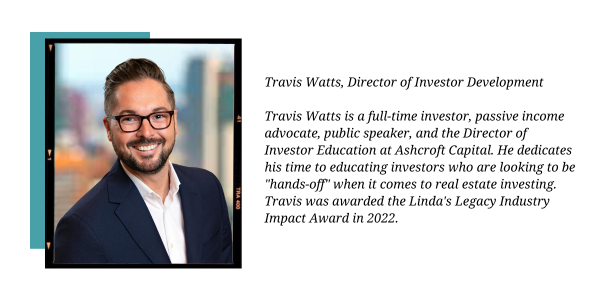December 13, 2023
By: Travis Watts, Director of Investor Development
In the world of investing, risk and reward are two sides of the same coin. A crucial concept in this space is the risk premium.
In this episode of Multifamily Investing 101, Director of Investor Development Travis Watts explains the importance of understanding risk premium in investments. By grasping this principle, investors are better equipped to align their investment choices with their financial objectives and risk appetite.
Unraveling the Concept of Risk Premium
Simply put, risk premium is the extra return an investor expects to earn by choosing riskier investments over safer ones. The risk premium acts as compensation for the extra risk undertaken. But to understand this concept fully, we need to first consider what constitutes safe investments. Typically, these are low-risk, low-volatility options. However, it’s important to note that safe doesn’t necessarily equate to risk-free or a guaranteed yield.
The Risk-Free Rate
At the core of the risk premium concept is the risk-free rate. This is the return offered by the safest possible investment, often represented by government bonds. The risk-free rate forms the baseline against which riskier investments are measured. The rationale is simple: why take on more risk unless the potential reward is higher than the yield of a risk-free investment?
Calculating Risk Premium
The formula for calculating risk premium is quite straightforward: it’s the difference between the expected return of an investment and the risk-free rate.
Why Risk Premium Matters
Understanding the risk premium is vital for both new and seasoned investors.
For Novice Investors:
- Diversify your portfolio: Spread your investments across different asset classes, such as multifamily real estate, to reduce the impact of individual asset risk.
- Understand risk tolerance: Assess your risk tolerance honestly. This involves evaluating your ability and willingness to take on risk. Use risk assessment tools provided by financial institutions to determine an appropriate asset allocation that matches your risk tolerance.
- Educate yourself: Take the time to learn about different investment options, financial markets, and economic factors that can affect your investments. Understanding the basics of investing can help you make informed decisions.
For Experienced Investors:
- Assess the risk and return relationship: Continuously evaluate the risk-return trade-off of your investments. Ensure your portfolio continues to align with your risk appetite and financial goals.
- Investment strategy: Assess whether your investment strategies are suitable for your goals. Different investment strategies might involve higher costs and require more time and expertise to manage but can potentially generate higher returns. In contrast, multifamily syndications, for example, aim to match market returns at lower costs.
- Rebalance regularly: Rebalance your portfolio periodically to maintain your desired asset allocation. This ensures that you don’t become overexposed to higher-risk assets during bull markets or too conservative during bear markets.
- Stay informed: Keep up with financial news, market developments, macroeconomic trends, and geopolitical events that can impact your investments.
The Influence of Economic Conditions
Economic conditions significantly impact risk premiums. In stable times, the risk premium is generally lower. Conversely, during economic downturns or uncertainty, the risk premium tends to rise.
The Role of Diversification
Diversification plays a critical role in managing risk premiums. By spreading investments across various asset classes, investors can balance the risk and returns in their portfolio. This strategy can smooth out the bumps caused by fluctuations in risk premiums.
To Bring it All Together
Risk premium is an essential concept in investing that provides a framework for understanding and managing the trade-off between risk and return. Although the pursuit of higher returns through riskier investments can be enticing, it’s crucial to understand the risk premium involved. By mastering this concept, investors can make more informed decisions, tailor their investment strategy to their risk tolerance, and potentially enhance their investment returns.
The “Multifamily Investing 101” YouTube series is dedicated to unraveling the intricacies of multifamily investing and the real estate industry. In this series of concise, informative videos, we aim to provide you with a comprehensive understanding of key terms and concepts necessary for navigating multifamily investing. Whether you’re a seasoned professional seeking to deepen your knowledge or a newcomer looking to build a strong foundation, these videos are designed to equip you with the expertise you need to navigate the multifamily real estate market with confidence.




